EA’s FIFA 23 is the last ever football simulation video game under the FIFA franchise as both EA and FIFA have parted ways. So, we’ll witness a new edition of the football gaming lineup by EA from now on. FIFA 23 includes men’s and women’s FIFA World Cup with crossplay features and HyperMotion2 technology to improve the gaming experience. However, several players are encountering the FIFA 23 High CPU Usage Issue on their Windows machines so often.
Let’s take a quick look at the FIFA 23 reviews on Steam for the PC version as well as some other online forums. It’s worth mentioning that PC version players aren’t happy with this latest release due to the lack of multiple features, traditional bugs or glitches, startup crashes, and more. At the same time, some other players are experiencing high usage of system resources on the PC while playing the FIFA 23 game even though their machine configuration is powerful enough.
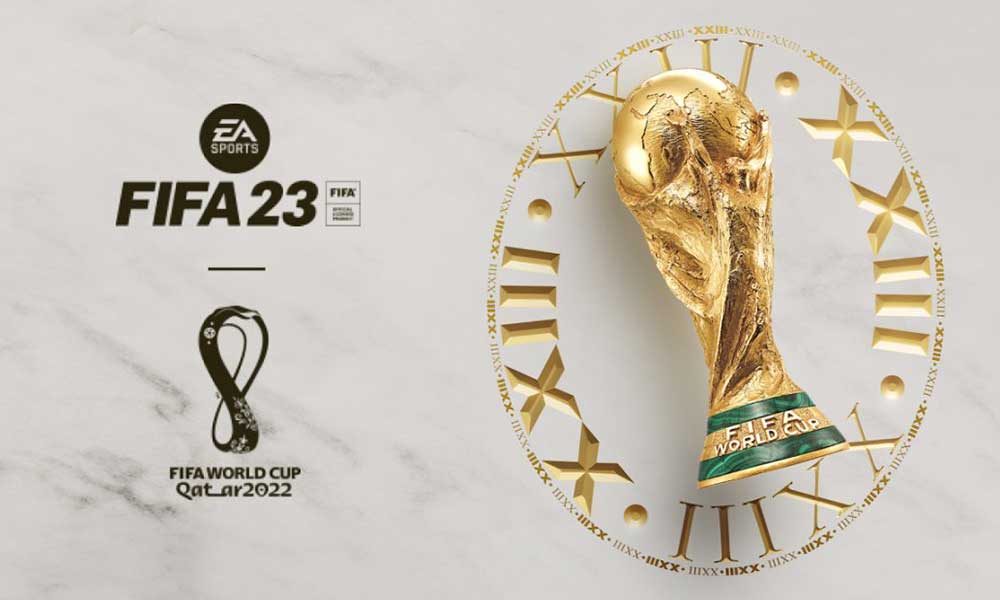
Page Contents
- Fix: FIFA 23 High CPU Usage Issue
- 1. Run the game as Administrator
- 2. Use the External/Dedicated Graphics Card
- 3. Adjust In-Game Graphics Settings
- 4. Turn On Hardware-accelerated GPU Scheduling
- 5. Disable Dynamic Resolution Scale in FIFA 23
- 6. Update GPU Drivers
- 7. Close Background Running Tasks
- 8. Use the Best Performance Power Plan
- 9. Update FIFA 23
- 10. Verify and Repair Game Files
- 11. Chipset Drivers are Outdated
- 12. Try Disabling Overlay Apps
- 13. Turn Off Antivirus Protection
- 14. Perform a Clean Boot
- 15. Restore Default to Overclocked CPU or GPU
Fix: FIFA 23 High CPU Usage Issue
Well, not only the gameplay sessions but also the intro cutscenes stutter a lot most of the time which becomes frustrating. It looks like there are plenty of possible reasons applicable behind the high CPU usage issue on your computer which you should try recognizing and fixing manually. The chances are high that the outdated system software, an outdated game patch version, corrupted or missing game files, an outdated GPU driver, etc can be a reason.
Whereas conflicts with the DirectX version, in-game graphics settings issues, unnecessary background running processes, issues with the startup applications on the system, power management conflicts, always running overlay applications, and more might trigger the high CPU usage or low framerate count problem whatsoever. Luckily, we’ve mentioned some troubleshooting methods for you to fix it. So, without wasting any more time, let’s get into it.
1. Run the game as Administrator
Make sure to run the game app file on your PC as administrator access to allow the User Account Control (UAC) access to the system. In some cases, your system requires the UAC access permission to run a program which is quite important. By following the steps below you’ll have to allow the admin access for once and it won’t ask you for the same again. To do so:
- Go to the installed FIFA 23 game directory.
- Right-click on the game application file on your PC.
- Click on Properties > Click on the Compatibility tab.
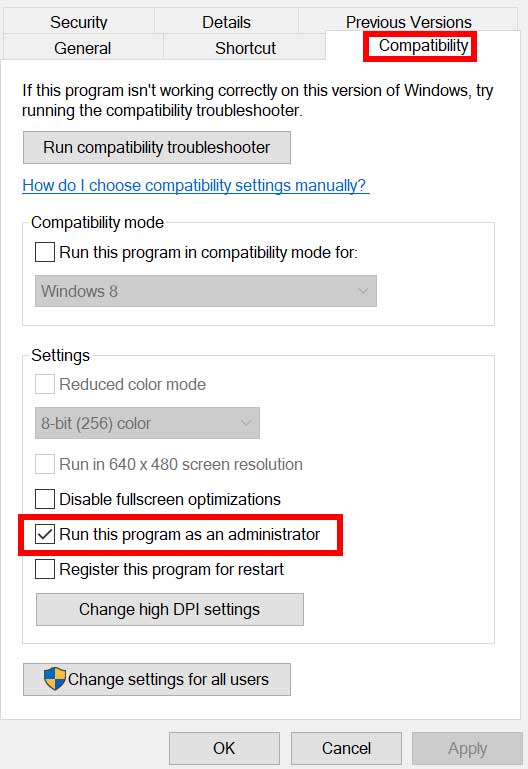
- Click on the Run this program as an administrator checkbox to enable it.
- Once done, click on Apply and then OK to save changes.
- Finally, run the game to check for the issue.
Please Note: If you’re using the Steam or Epic Games or EA App client on the PC then make sure to perform the same steps for the respective launcher to grant the admin access.
2. Use the External/Dedicated Graphics Card
It’s highly recommended to use the external or dedicated graphics card on your system rather than using the onboard graphics. Onboard graphics with the chipset won’t be able to handle graphics-intensive tasks smoothly and that’s why graphics-hungry programs like video games do crash or stutter a lot. Whether you’re using an Nvidia graphics card or an AMD graphics card, you can follow the steps below to select the dedicated GPU for the game.
For Nvidia GPU:
- Launch the Nvidia Control Panel menu.
- Go to Manage 3D Settings > Click on Program Settings.
- Click on Add and browse to the installed FIFA directory.
- Then select FIFA 23 launcher application > Select the dedicated GPU (High Performance).
- Next, you’ll have to adjust the following settings in ‘Specify the settings for this program’.
- Open GL rendering GPU and select your dedicated GPU card.
- Select Power Managment Mode > Click on Prefer Maximum Performance.
- Choose Vertical Sync > Select Adaptive. (DO NOT choose Adaptive – half refresh rate)
- Once done, make sure to save the changes, and restart your game.
For AMD GPU:
- Press the Win+X keys to open the Quick Link Menu.
- Go to Device Manager from the list.
- Click on the Display Adapter arrow icon to expand the list.
- Now, you’ll have to right-click on the inbuilt GPU and disable it.
- Reboot your system to apply changes.
3. Adjust In-Game Graphics Settings
You should try adjusting the in-game graphics settings as per your preference depending on which configuration you’re using and what kind of performance you want. If in case, you’re not sure which options to play with then make sure to follow the steps below to easily adjust graphics options to try.
- Open the FIFA 23 game on the PC > Head over to the Settings menu.
- Make sure to set the Display Resolution to 1920×1080 (16:9 aspect ratio) or higher.
- Display Mode: Full Screen
- Frames per second: No limit
- Dynamic Scaling: Disabled
- Hair strands: Off
- Rendering quality: Low
- Maximum Frequency Control: On
- Max FPS: 60 to 100 (depends on your monitor and hardware)
- Anti-aliasing: Use application settings
- Anti-aliasing method: Multiple sampling
- (MLAA) Edge smoothing: Disabled
- Anisotropic Filtering: Enabled
- Filter Level: 16x
- Texture Filtering Quality: High
- Surface Format Optimization: Disabled
- Tessellation mode: AMD
- Triple buffering: Disabled
- 10-bit format: Disabled
- GPU Loads: Graphics
- Global Screen Settings: Ensure to Turn Off Everything
- Scaling mode: Keep aspect ratio
- AMD FreeSync: AMD Optimization
4. Turn On Hardware-accelerated GPU Scheduling
Some reports are claiming that enabling the Hardware-accelerated GPU Scheduling feature on the Windows machine might help the FIFA 23 game to run properly by boosting the game performance and reducing online latency. To do so, you can follow the steps below:
- Press the Win+I keys to open Windows Settings.
- Click on System > Go to Display.
- Go to Graphics > Click on Change default graphic settings.
- Now, make sure to Enable the Hardware-accelerated GPU Scheduling feature.
- Once done, make sure to reboot the PC to apply changes.
5. Disable Dynamic Resolution Scale in FIFA 23
If the above methods didn’t work for you then make sure to turn off the Dynamic Resolution Scale option in the FIFA 23 game to check for the high CPU usage issue on your PC. To do so:
- Launch FIFA 23 > Go to the Settings menu.
- Click on Game Settings > Select Display Configuration.
- Here you’ll have to Turn Off the Dynamic Resolution Scale option.
6. Update GPU Drivers
An outdated or corrupted graphics card driver can trigger multiple issues with the games or system performance while running programs. It’s highly recommended to check the graphics driver update. To do so:
- Press the Win+X keys to open the Quick Link Menu.
- Click on Device Manager from the list > Double-click on Display adapters.
- Right-click on the dedicated graphics card that you’re currently using.
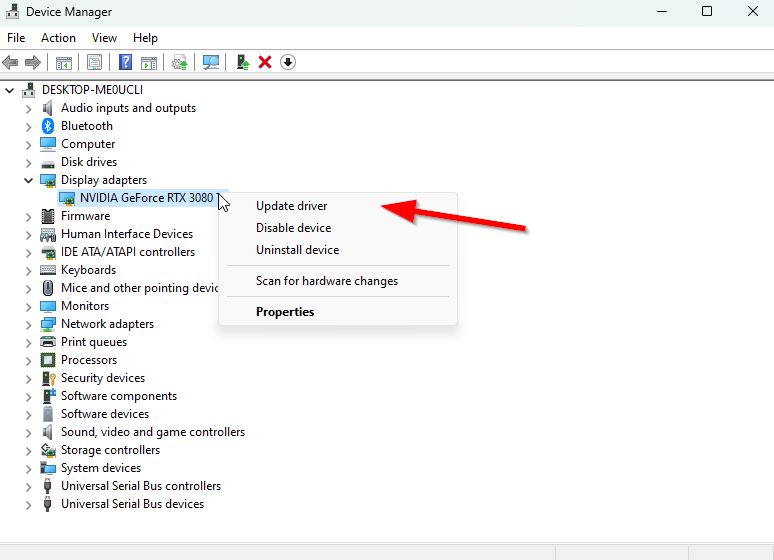
- Click on Update driver > Choose Search automatically for drivers.
- If there is the latest update available, it’ll automatically download & install the latest version.
- Once done, restart the computer to apply changes immediately.
Alternatively, you can manually download the latest version of the graphics driver and install it on the PC via the official website. Make sure to download the graphics driver file respective to your graphics card model and manufacturer. Nvidia graphics card users can update the GeForce Experience app via the Nvidia official site and AMD graphics card users can visit the AMD website for the same. While Intel graphics users can visit here.
7. Close Background Running Tasks
Unnecessary background running tasks or programs can eat up a lot of system resources like CPU or Memory usage literally reducing system performance. Hence, the startup crashing, lagging, and not loading issues appear quite often. Simply, close all the unnecessary background running tasks completely. To do this:
- Press the Ctrl+Shift+Esc keys to open up Task Manager.
- Now, click on the Processes tab > Click to select tasks that are unnecessarily running in the background and consuming enough system resources.
- Click on End Task to close them one by one.
- Once done, restart your system.
8. Use the Best Performance Power Plan
It’s also highly recommended to change the power plan on the computer because the Windows system basically uses the Balanced power plan by default. But it reduces performance which can be improved by changing the power plan. Keep in mind that the performance plan can consume higher power. To do so:
- Press the Win+R keys to open the Run dialog box.
- Type Control Panel in the field and click on OK from the search result to open it.
- Now, search for Power Options (Power & battery) and open it.
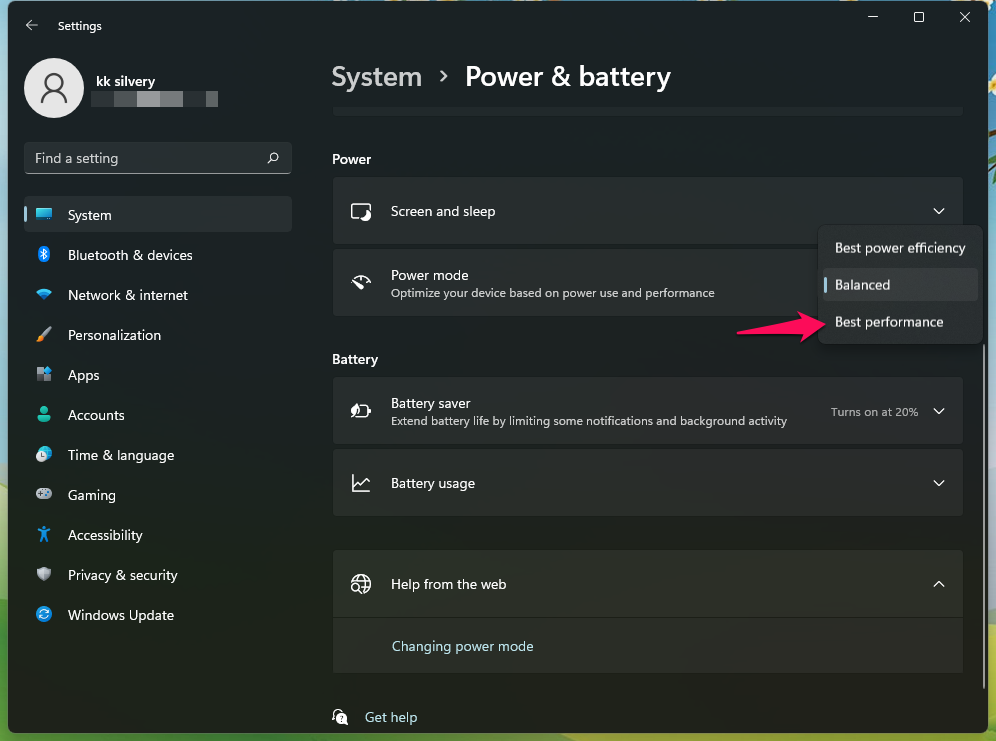
- Click on Best Performance > Reboot your PC to save changes immediately.
9. Update FIFA 23
In some scenarios, it’s always a better idea to update the game version because an outdated game patch version can trigger several potential issues on the gaming device that leads to crashes, lags, stutters, CPU/GPU-related issues, and more. To do so:
For Steam:
- Open the Steam client > Go to Library.
- Click on FIFA 23 from the list of installed games on the left pane.
- Now, the client will automatically search for the available update.
- If there is an update available, you’ll see the Update option > Just click on it.
- Wait for a couple of minutes or so until the game update completes.
- Once done, make sure to close the Steam client.
- Finally, reboot your PC to apply changes.
For Epic Games Launcher:
- Open the Epic Games Launcher > Head over to Library.
- Now, click on the three dots icon next to FIFA 23.
- Make sure the Auto Update option is turned on.
- It should automatically install the available update of the game.
For Origin:
- Launch the Origin client on your computer.
- Go to Library > Right-click on FIFA 23.
- Select Check for Update > If available, proceed with the same.
- It may take some time to complete the update.
- Once done, you can reboot the PC to apply changes.
10. Verify and Repair Game Files
Sometimes corrupted or missing game files on the PC may trigger some issues with the game launching or running smoothly. Make sure to verify the game files and repair them via the Steam or Battle.net client by following the steps below:
For Steam:
- Open the Steam client on the PC and log into the account > Head over to Library.
- Right-click on the FIFA 23 game from the left pane.
- Click on Properties > Click on the Local Files tab.
- Then click on Verify Integrity of game files.
- Now, wait for the process to complete, and close the Steam client.
- Finally, restart the PC to apply changes.
For Origin Client:
- Open the Origin client on your PC.
- Navigate to the My Game Library > Select FIFA 23.
- Now, click on Settings (Gear icon) and select Repair.
- Wait for the process to be completed.
- Finally, reboot the PC to apply changes.
For Epic Games Launcher:
- Open the Epic Games Launcher > Click on Library.
- Click on the three-dots icon next to FIFA 23.
- Now, click on Verify, and then wait for it to complete.
- Reboot the PC and check for the issue again.
11. Chipset Drivers are Outdated
If in case, your chipset drivers are outdated on the PC then such issues might appear a lot. It’s always a better idea to check for updates and fix the low CPU usage or even not using the CPU while playing games. To do so:
- Press the Win+X keys to open the Quick Link Menu.
- Click on Device Manager from the list > Double-click on System devices.
- Right-click on the active chipset device from the list.
- Click on Update driver > Choose Search automatically for drivers.
- If there is the latest update available, it’ll automatically download & install the latest version.
- Once done, restart the computer to apply changes immediately.
Alternatively, you can directly visit the official chipset manufacturer’s website and grab the latest version of the processor model based on its architecture (64-bit). You can check the links below.
12. Try Disabling Overlay Apps
Sometimes a couple of applications may come with an additional overlay app that basically helps the streamers or gamers a lot. However, these overlay apps can eventually conflict with the game files to run smoothly and may cause several issues like FPS drops, black screen issues, lags, glitches, etc. You should try disabling the overlay apps manually before launching the game again to cross-check whether the crashing issue has been fixed or not. To do so:
Disable Discord Overlay:
- Launch the Discord app > Click on the gear icon at the bottom.
- Select Overlay under App Settings > Turn on the Enable in-game overlay.
- Click on the Games tab > Select FIFA 23.
- Finally, turn off the Enable in-game overlay toggle.
- Make sure to reboot your PC to apply changes.
Disable Xbox Game Bar:
- Press the Win+I keys to open Windows Settings.
- Click on Gaming > Go to Game Bar > Turn off Record game clips, screenshots, and broadcast using the Game bar option.
Disable Nvidia GeForce Experience Overlay:
- Launch the Nvidia GeForce Experience app > Head over to Settings.
- Click on the General tab > Disable the In-Game Overlay option.
- Finally, restart the PC to apply changes, and launch the game again.
There are some other overlay apps that can cause trouble for you something as MSI Afterburner, Rivatuner, RGB software, etc. You should turn them off as well.
13. Turn Off Antivirus Protection
You can also try turning off the Windows Defender option on your PC to ensure there is no antivirus software blocking the game files to run properly.
- Press the Win+I keys to open Windows Settings.
- Click on Update & Security > Click on Windows Security from the left pane.
- Now, click on the Open Windows Security button.
- Go to Virus & threat protection > Click on Manage settings.
- Next, you’ll need to turn off the Real-time protection toggle.
- If prompted, click on Yes to proceed further.
If in case, you’re using any other antivirus program on your PC then make sure to turn it off.
14. Perform a Clean Boot
Multiple users claimed that performing a clean boot on the PC did fix the system boot-up issue because some apps or tasks start at the very beginning. These tasks run all the time and consume a lot of system resources. You should follow the steps below to do so:
- Press the Win+R keys to open the Run dialog box.
- Type msconfig and hit Enter to open System Configuration.
- Go to Services > Click on Hide all Microsoft services to enable it.
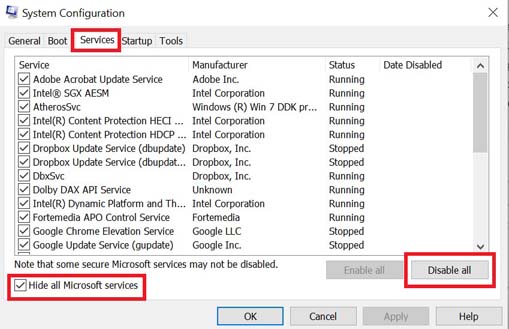
- Now, click on Disable all so that the rest of the services gets turned off.
- Click on Apply and then OK to save changes.
- Next, go to Startup > Click on Open Task Manager.
- Click on the Startup tab > Ensure to select the specific task that has a higher startup impact.
- Now, click on Disable to turn it off.
Please Note: Do the same steps for each program that has a higher startup impact except for the audio or graphics service.
- Finally, make sure to restart your computer to apply changes.
15. Restore Default to Overclocked CPU or GPU
Sometimes overclocked CPU or GPU on the PC might cause conflicts with the other hardware which may trigger a bottleneck issue. It’s better to temporarily disable or restore the overclocked CPU/GPU to the factory default so that you can check out the potential reason behind the crashing issue. There are multiple tools available online to adjust overclocked CPU or GPU on the PC such as MSI Afterburner, Riva Tuner, AMD Ryzen Master, EVGA Precision X, etc.
That’s it, guys. We assume this guide was helpful to you. For additional queries, you can comment below.
Also Read
FIFA 23 Anti Cheat Error, How to Fix?
Fix: FIFA 23 Can’t Play Rivals
Is There A Free Activation Key For FIFA 23?
Fix: FIFA 23 Player Stuck in Transfer Targets
Fix: FIFA 23 Music Not Playing
Fix: FIFA 23 Error 87 The parameter is Incorrect
Fix: FIFA 23 Pro Club Player Not Moving Issue
Fix: FIFA 23 Error Creating Game Session
How to Fix FIFA 23 Controller Not Working on PC
